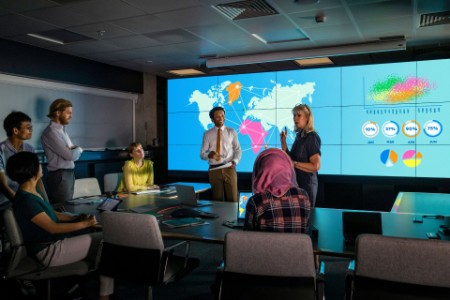How do you create new value through digitalization?
Investors have plenty of cash reserves to pay top prices for companies. The fact that investors are also counting on solid added value presents these companies with quite a task. “It's not about digitalizing, but about creating added value.”
At EY-Parthenon, the strategy consulting arm of EY and a relatively young offshoot of the EY tree, Marc Herlant and Stijn Spitaels assist their clients in defining and working towards their strategic ambitions. Although active in Belgium for just three years, they observe considerable interest in the market.
Which for Stijn Spitaels is not surprising: “Private equity fund managers who are now looking at targets know that they are going to pay a lot for them. But their perspective is often short or medium-term: typically four to five years. Investors, therefore, need to think from day one about how they are going to create value with their investment.”
There was a time when that increase in value could simply come from bolting companies together, taking a few people out of the overheads, and waiting for the underlying market growth to do its job. Those days are long gone. “The world has become much more complex owing to technology, regulations and increasing diversity, and higher consumer expectations and demands. Today all aspects – the strategic choices, plus the various operational aspects and the financial and tax structure – have to be examined very carefully.”
Related article
Strategic reorientation
To make their point, Herlant and Spitaels use the story of Q-Park, a family business in parking services that has worked its way up from scratch to a leading position in Northern Europe over the past 25 years. A few years ago, the original shareholders brought a new CEO on board in the person of Frank De Moor, and announced that they would like to step out. De Moor went looking for a buyer and came across the infrastructure fund of private equity player KKR. For Herlant and Spitaels, a new CEO and a new investor are typical triggers that can force a company to refocus strategically in order to accelerate growth and seize new market opportunities.
You don't park to park. You always park in order to do something else.
Frank De Moor, with long experience in digitalization and mobile telephony, was convinced from the outset that the parking world was set to change dramatically. For him, Q-Park’s founders were the first to see parking not as a real estate operation, but as a consumer event: “You don’t park to park. You always park in order to do something else.”
A realization that only slowly dawned on the rest of the sector: “At the first European Parking Association conference I attended in 2014, all sorts of things were discussed. Except the end-user: the person parking his or her car.” De Moor, however, realized that car parkers were going to demand more and more control. That’s why he started the PASS - parking as a smart service – project at Q-Park.
Creating new value
When Frank De Moor called Herlant and Spitaels, a number of digitalization projects had already been launched or even completed, such as number plate recognition: “Clients register via an app or a website,” explains De Moor, “the barrier opens automatically on entering and leaving the car park: no more taking a ticket, no more queuing at the machine.” But digitalization projects like this also happen elsewhere, the CEO realized.
Q-Park's question to EY-Parthenon was therefore not 'How do we digitalize?' but about 'How do we use digitalization to create new value?'.
Q-Park mastered all the technological elements and was able to offer a good service. “The big challenge consists of translating this into value creation. What are the different market segments? What evolutions are expected in the coming years? What does the future hold technology-wise? What is the competition doing? And how is the legal context evolving?” But also: “Who are possible partners and how can we assess potential collaborations? How will they impact our EBITDA? We analyze this with a realistic view of the organization’s capabilities and overall priorities. The objective? An ambitious, but feasible implementation. Consultants can play an important supporting role here, as accelerators and enablers.”

Beyond digitalization
This brings us to what is for Herlant and Spitaels the core of the strategic exercise: “You can view automation as something you’ve already done, or do faster or cheaper,” says Herlant, “but real new value is created only if you can use digitalization to offer new products.”
In the parking sector, for example, digital communication with the client opens up the possibility of organizing temporary car parks, like on a meadow for a one-off concert. The digital highway also permits partnerships with other digital players. You evolve from parking operator to central mobility player. De Moor hardly knows where to start when he lists all the people with whom Q-Park works: “In Belgium, we have been working with Cambio for many years and every KBC app user can enter and exit all Q-Parks automatically by simply entering their number plate. We also respond to the mobility wallet that the government is keen to organize with Skipr, the mobility budget where employees choose whether to use it to pay for a bus or a parking space. For hotels and restaurants, we are looking to put a button on the website with which, for example, clients wishing to reserve a hotel room also immediately book their parking space.”
New value is only created if you can use digitalization to offer new products.
And then of course there are the scooters and bicycles, both private and shared. And the city authorities. To them, Q-Park presents itself as a specialist in complex projects, helping to use the public space as efficiently as possible. This is possible, for example, in the form of parking subscriptions for residents with cars that the city council wants off the street.
EV charging
Of course, the electric car is calling for a lot of attention. De Moor explains that for a not insignificant part of his clientele, 'charging at home' means: 'in the parking garage'. And so parking garages must be equipped with EV charging. The question then becomes: who makes the investment? In an 'asset-light model', EV charging is an extra convenience that the parking garage offers its clients, but for which someone else makes the investments.
But from a strategic point of view, Herlant & Spitaels advised Q-Park to make the investment themselves: “In principle, these charging points generate new income. In fairness, we have to say that in the short term there’s not much to be made from selling electricity, but that in these sorts of things you can take the long view. Moreover, in this way you keep control over the price that your customers pay for the electricity. But most importantly, it gives Q-Park control over the next step in the mobility value chain. And you can create new products such as park & charge, for example.” And providing cars with electricity also provides a lot of information about those cars — and therefore about the clients. Together with license plate recognition, EV charging can make the client a lot less anonymous, provided of course that all the GDPR rules are followed, and add value to the client by offering a more appropriate and individualized service.

A strategy delivers added value only if effectively implemented
All looks nice on paper, but all too often the result has been a well-written report that ends in a drawer. “Strategy is a necessary, but not sufficient condition for success. Our clients have still to implement this strategy and translate it into concrete financial results in their profit and loss accounts and as value creation for their shareholders”, says Herlant. “With a good strategic plan, I can't just call my seven boards together and say: this is it! No, I have to convince every national management. And, within every country, then every region, every city.” De Moor adds. De Moor appreciates the fact that people like Herlant and Spitaels at EY-Parthenon are not only able to think strategically, but also have an eye for implementation.
We accompany our clients not only in defining their strategies but also in the post-transaction transformation and value creation process.
For Stijn Spitaels, having an eye for designing and executing the plan fully in line with the strategy — the phase in which the actual value creation takes place — is precisely the reason for the existence of the new EY offshoot. “While our EY colleagues in our ‘Strategy and Transactions’ department focus primarily on the deal itself (an investment, an acquisition), we guide our clients not only in defining their strategies but also in the post-transaction transformation and value creation process. The fact that specialists are available behind every second door at EY for every possible step and dimension allows us to really put words into actions.”
The team
Contact us
Interested in the changes we have made here,
contact us to find out more.



